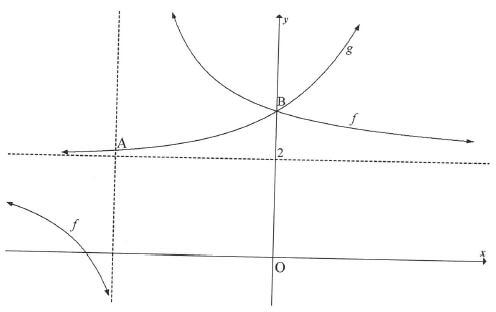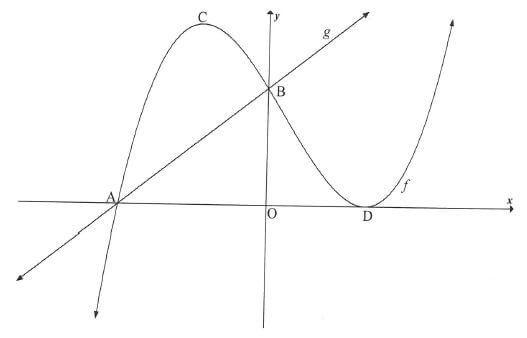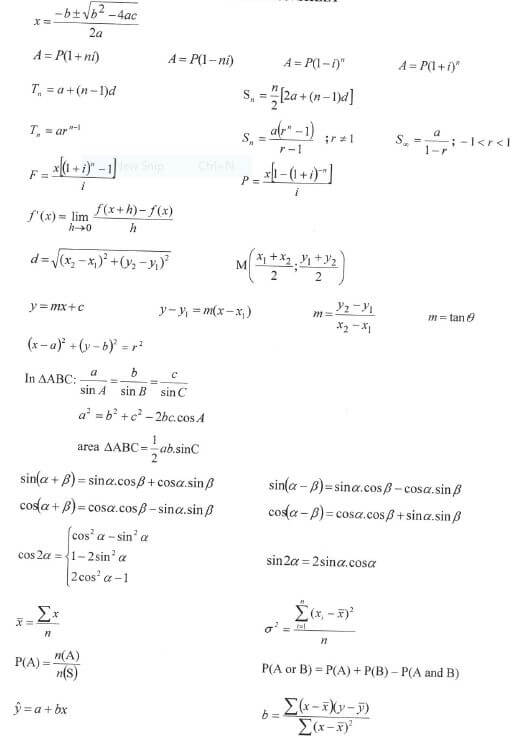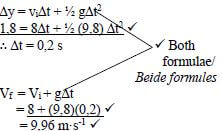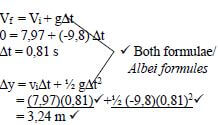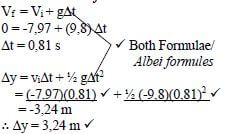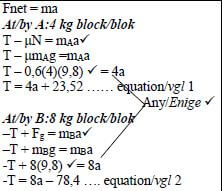Adele
GRADE 12 MATHEMATICS PAPER 1 QUESTIONS- SENIOR CERTIFICATE EXAMINATIONS PAST PAPER MAY/JUNE2016
Mathematics Paper 1
Grade 12
Senior Certificate Examinations
Past Papers 2016
INSTRUCTIONS AND INFORMATION
Read the following instructions carefully before answering the questions.
- This question paper consists of 11 questions.
- Answer ALL the questions.
- Number the answers correctly according to the numbering system used in this question paper.
- Clearly show ALL calculations, diagrams, graphs, et cetera that you have used in determining your answers.
- Answers only will not necessarily be awarded full marks.
- You may use an approved scientific calculator (non-programmable and non-graphical), unless stated otherwise.
- If necessary, round off answers to TWO decimal places, unless stated otherwise.
- Diagrams are NOT necessarily drawn to scale.
- An information sheet with formulae is included at the end of the question paper.
- Write neatly and legibly.
QUESTIONS
QUESTION 1
1.1 Solve for x:
1.1.1 4x2 – 25 = 0 (3)
1.1.2 x2 – 5x - 2 = 0 (correct to TWO decimal places) (3)
1.1.3 (2 - x)(x+4) ≥ 0 (3)
1.1.4 x - 3x½ = (5)
1.2 Solve for x and y:
2x – y +1=0 and x2 – 3x -4- y = y2 (6)
1.3 Given: f(x) = √12x+1
1.3.1 Write down the domain of f. (1)
1.3.2 Solve for x if f(x)=2x-1. (5)
[26]
QUESTION 2
2.1 Given the arithmetic series: a + 13 + b + 27 + ...
2.1.1 Show that a=6 and b = 20 (2)
2.1.2 Calculate the sum of the first 20 terms of the series. (3)
2.1.3 Write the series in QUESTION 2.1.2 in sigma notation. (2)
2.2 Given the geometric series: (x - 2)+(x2 – 4)+(x3 + 2x2 - 4x - 8) + ...
2.2.1 Determine the values of x for which the series converges. (4)
2.2.2 If x= -3/2, calculate the sum to infinity of the given series. (3)
[14]
QUESTION 3
The first four terms of a quadratic number pattern are -1 ; 2 ; 9 ; 20.
3.1 Determine the general term of the quadratic number pattern. (4)
3.2 Calculate the value of the 48th term of the quadratic number pattern. (2)
3.3 Show that the sum of the first differences of this quadratic number pattern can be given by Sn = 2n2 +n (3)
3.4 If the sum of the first 69 first differences in QUESTION 3.3 equals 9 591 (that is, S69 = 9 591), which term of the quadratic number pattern has a value of 9 590? (2)
[11]
QUESTION 4
The sketch below shows the graphs of f(x) = -x2 – 2x+3 and g(x)= mx +q.
Graph f has x-intercepts at A and B(1 ;0) and a turning point at C.
The straight line g, passing through A and C, cuts the y-axis at E.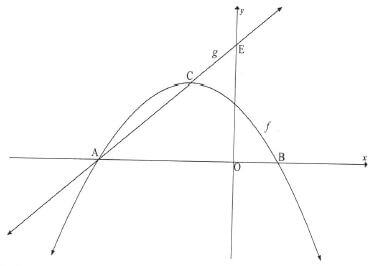
4.1 Write down the coordinates of the y-intercept of f. (1)
4.2 Show that the coordinates of Care (-1; 4). (3)
4.3 Write down the coordinates of A. (1)
4.4 Calculate the length of CE. (6)
4.5 Determine the value of k if h(x) = 2x +k is a tangent to the graph of f. (5)
4.6 Determine the equation of g-1, the inverse of g, in the form y= ... (2)
4.7 For which value(s) of x is g(x)≥ g-1(x)? (3)
[21]
QUESTION 5
The sketch below shows the graphs of f(x) = 3 + q and g(x) = 2x +r
x - p
- g intersects the vertical asymptote of f at A.
- B is the common y-intercept of f and g.
- y= 2 is the common horizontal asymptote of f and g.

5.1 Write down the value of r. (1)
5.2 Determine the value of p. (4)
5.3 Determine the coordinates of A. (3)
5.4 For which value(s) of x is f(x) - g(x) ≥ 0? (2)
5.5 If h(x) = f(x-2), write down the equation of h. (2)
[12]
QUESTION 6
6.1 How long would the price of an asset take to reduce by a third of its original value if it depreciates on a reducing balance at a rate of 4,7% p.a.? (4)
6.2 Lebogo bought a tractor for Rx on 1 April 2016.
- She will trade in this tractor when she replaces it with a similar one in 5 years time on 1 April 2021.
- The tractor depreciates by 20% p.a. according to the reducing-balance method.
- The price of a similar tractor increases by 18% annually.
- Lebogo calculated that if she deposited R8 000 per month into a sinking fund, which paid interest at 10% p.a. compounded monthly, she would have enough money to cover the replacement cost of the tractor. She made the first deposit in this fund on 30 April 2016 and will continue to do so at the end of every month until 31 March 2021.
6.2.1 Determine, in terms of x, what the book value of the current tractor will be on 1 April 2021 (that is, 5 years after it was bought). Give your answer correct to FIVE decimal places. (2)
6.2.2 Determine, in terms of x, what the price of a similar new tractor will be on 1 April 2021. Give your answer correct to FIVE decimal places. (2)
6.2.3 Calculate the amount accumulated in the sinking fund on 1 April 2021. (4)
6.2.4 Calculate the value of x, the price of the current tractor. Round off your answer to the nearest thousand. (4)
[16]
QUESTION 7
7.1 Determine f′(x) from first principles if f(x) = 3x2 - 5 (5)
7.2 Determine dy/dx if:
7.2.1 y=2x5 + 4/x3 (3)
7.2.2 y=(√x-x2)2 (4)
[12]
QUESTION 8
Sketched below are the graphs of f(x) = (x - 2)2(x - k) and g(x) = mx +12
- A and D are the x-intercepts of f.
- B is the common y-intercept of f and g.
- C and D are turning points of f.
- The straight line g passes through A.

8.1 Write down the y-coordinate of B. (1)
8.2 Calculate the x-coordinate of A.(3)
8.3 If k=-3, calculate the coordinates of C. (6)
8.4 For which values of x will f be concave down? (3)
[13]
QUESTION 9
A 340 ml can with height h cm and radius r сm is shown below. 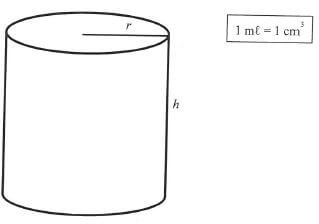
9.1 Determine the height of the can in terms of the radius r. (3)
9.2 Calculate the length of the radius of the can, in cm, if the surface area is to be a minimum. (6)
[9]
QUESTION 10
10.1 A tournament organiser conducted a survey among 150 members at a local sports club to find out whether they play tennis or not. The results are shown in the table below.
| PLAYING TENNIS | NOT PLAYING TENNIS | |
| Male | 50 | 30 |
| Female | 20 | 50 |
10.1.1 What is the probability that a member selected at random is:
(a) Female (2)
(b) Female and plays tennis (1)
10.1.2 Is playing tennis independent of gender? Motivate your answer with the necessary calculations. (3)
10.2 The probability of events A and B occurring are denoted by P(A) and P(B) respectively.
For any two events A and B it is given that:
- P(B') = 0,28
- P(B) = 3P(A)
- P(A or B) = 0,96
Are events A and B mutually exclusive? Justify your answer. (4)
[10]
QUESTION 11
Five boys and four girls go to the movies. They are all seated next to each other in the same row.
11.1 One boy and girl are a couple and want to sit next to each other at any end of the row of friends. In how many different ways can the entire group be seated? (3)
11.2 If all the friends are seated randomly, calculate the probability that all the girls are seated next to each other. (3)
[6]
TOTAL: 150
INFORMATION SHEET

ACCOUNTING PAPER GRADE 12 MEMORANDUM - AMENDED SENIOR CERTIFICATE EXAM PAST PAPERS AND MEMOS MAY/JUNE 2016
ACCOUNTING
GRADE 12
SENIOR CERTIFICATE EXAM
MEMORANDUM
JUNE 2016
MARKING PRINCIPLES:
- Penalties for foreign items are applied only if the candidate is not losing marks elsewhere in the question for that item (no foreign item penalty for misplaced item). No double penalty applied.
- Penalties for placement or poor presentation (e.g. details) are applied only if the candidate is earning marks on the figures for that item.
- Full marks for correct answer. If the answer is incorrect, mark the workings provided.
- If a pre-adjustment figure is shown as a final figure, allocate the part-mark for the working for that figure (not the method mark for the answer).
- Unless otherwise indicated, the positive or negative effect of any figure must be considered to award the mark. If no + or – sign or bracket is provided, assume that the figure is positive.
- Where indicated, part-marks may be awarded to differentiate between differing qualities of answers from candidates.
- This memorandum is not for public distribution, as certain items might imply incorrect treatment. The adjustments made are due to nuances in certain questions.
- Where penalties are applied, the marks for that section of the question cannot be a final negative.
- Where method marks are awarded for operation, the marker must inspect the reasonableness of the answer before awarding the mark.
- In awarding method marks, ensure that candidates do not get full marks for any item that is incorrect at least in part.
- Be aware that some candidates provide valid alternatives beyond the memorandum.
- Codes: f = foreign item; p = placement/presentation.
MEMORANDUM
QUESTION 1
VALUE ADDED TAX
1.1 (3)
| 1.1.1 | True✓ |
| 1.1.2 | False✓ |
| 1.1.3 | False✓ |
1.2.1 (12)
| Calculate the VAT amount that is either payable to or receivable from SARS. 62 300: three marks 44 800 ✓ + 69 300 ✓ – 7 000 ✓✓– 23 520 ✓ – 6 440 ✓– 4 900 ✓+ 840 ✓✓ – 2 352 ✓✓= 70 728 ☑ appropriate operations one part correct Accept alternative arrangement for calculations (signs reversed; VAT control account, etc.) Mark one line only – cannot mix signs (award highest mark)
| ||||||
1.2.2 [2]
What comment would you offer Nelson concerning this practice? State ONE point.
|
1.3 CREDOTIR'S RECONCILIATION
1.3.1 [14]
| CREDITORS' LEDGER | CREDITORS' RECONCILIATION STATEMENT | |
| Balance | 110 170 | 111 600 |
| a | -11 000✓ | |
| b | +5 000✓ | |
| c | -28 800✓ | |
| d | +1 650✓✓ | |
| e | -2 400✓✓ | |
| f | -5 400✓✓ -2 700 1 mark -2 700 1 mark | |
| g | +3 300✓ | |
| h | -13 800✓ | |
| -1 380✓ | ||
| +44 400✓ | ||
| -15 180 two marks +29 220 three marks | ||
| 106 620 ☑(both totals) | 106 620 |
foreign items -1 per line if candidate earned a mark on that line
1.3.2 [4]
State TWO internal control measures that the business can use to prevent similar incidents from happening in future.
|
| TOTAL MARKS |
| 35 |
QUESTION 2
2.1 ABE ACCESSORIES
2.1.1 [15]
Factory Overhead Cost Note Presentation or incorrect / incomplete details -1 max -2
|
Foreign items: -1 max -2
2.1.2 [8]
Production Cost Statement for the year ended 29 February 2016
|
2.2 NEW FASHION MANUFACTURERS
2.2.1 [5], [3]
| Gloria is concerned about the wastage of direct materials. Calculate the number of metres of fabric that was wasted. Needed 4 500 x 2,5 = 11 250 metres ✓✓ Issued to factory: 11 500 metres ✓☑ (525 +12 450 – 1 475) one part correct Wasted: 11 500 – 11 250 = 250 metres☑ one part correct |
| Gloria feels that the wastage is significant. Provide a calculation to support her opinion. 250 ☑ /2,5 metres ✓ = 100 dresses ☑ one part correct OR 250/11 500 = 2,2% of material sent to the factory OR 100/4 500 = 2,2% of units soldOR250/ 11 250 = 2,2% of material needed |
2.2.2 [4]
Give TWO possible reasons for this wastage and, in EACH case, give advice to prevent this from happening in future.
| |||||||||||||||
2.2.3 [4], [4]
Calculate the break-even point for the year ended 29 February 2016. |
Explain why the business should be satisfied with the number of units made during the current financial year. State TWO points.
|
2.2.4 [3], [4]
| What effect will the import of the material have on the production cost of a dress? Provide a calculation to support your answer. The production cost per dress will decrease ✓ by R75. (2,5✓ x R30✓) |
State TWO other consequences of importing the direct material.
|
| TOTAL MARKS |
| 50 |
QUESTION 3
3.1 CONCEPTS [4]
| 3.1.1 | First in first out (FIFO) ✓ |
| 3.1.2 | Perpetual inventory system ✓ |
| 3.1.3 | Specific identification method ✓ |
| 3.1.4 | Periodic / Weighted-average method ✓ |
3.2.1 [8]
| Calculate the value of the closing stock on 29 February 2016 using the weighted-average method. Unit costs: = 320 770 ✓+ 1 392 380✓ – 22 650 ✓ 520 ✓ + 1 960 ✓ – 30 ✓ = 1 690 500 3 marks 2 450 3 marks = 690 six marks Stock value: 690 x 325 ✓ = R224 250 ☑ one part correct |
3.2.2 [6]
| Calculate the following for the year ended 29 February 2016: Cost of sales: Opening stock 320 770 Purchases 1 347 500 Returns (22 650) Carriage on purchases 44 880 See 3.2.1☑ 1 690 500 Closing stock See 3.2.1☑ (224 250) Cost of sales Operation - one part correct☑ 1 466 250 Gross profit: Sales (2 115 x 1 400) ✓2 961 000 Cost of sales See above ☑ (1 466 250) Gross profit Operation - one part correct☑ 1 494 750 |
3.2.3 [5]
Calculate the average stock-holding period (in days) on 29 February 2016. 422,50 three marks; 845 two marks |
3.2.4 [7]
| Calculate the value of the closing stock by using the FIFO method. (300 – 30) 270 ✓ x R755 ✓ = R203 850 ☑ one part correct 325 – 270 325 – figure above 55 ☑ x R740 ✓ = R40 700 ☑ one part correct = R244 550 ☑ one part correct |
3.3.1 [6]
Identify ONE problem in Shop 1 and ONE problem in Shop 2. Quote figures. In EACH case, state ONE point of advice.
|
3.3.2 [4]
Explain TWO good decisions that Chad has made in respect of Shop 3.
|
| TOTAL MARKS |
| 40 |
QUESTION 4
4.1 CONCEPTS [4]
| 4.1.1 | B ✓ |
| 4.1.2 | D ✓ |
| 4.1.3 | A ✓ |
| 4.1.4 | C ✓ |
4.2 PARADISE LIMITED
4.2.1 Ordinary Share Capital [6] Presentation or incorrect / incomplete details -1 max -2
| 3 000 000 | shares in issue at beginning | ✓6 000 000 |
| 1 000 000 | shares issued during the financial year | ✓5 000 000 |
| (200 000) | shares repurchased (average issue price: R2,75 ✓ per share) must be in brackets or subtracted if 200 000 or R2,75 is used | ☑(550 000) |
| 3 800 000✓ | shares in issue at end operation one part correct | ☑10 450 000 |
RETAINED INCOME [10] Presentation or incorrect / incomplete details -1 max -2
| Balance at beginning of year | 1 634 000 |
| Funds used for shares repurchasedFunds used for shares repurchased(200 000 x R1,10) OR 770 000 – OSC amount above770 000 – OSC amount above Do not accept 770 000 as a final -1 if no brackets | ☑☑(220 000) |
| Net profit after tax (3 800 000 ✓ – 1 064 000✓) one part correct | ☑2 736 000 |
| Ordinary share dividends must be in brackets or subtracted operation one part correct | ☑(2 600 000) |
| Interim | ✓840 000 |
| Final (4 000 000 x 44/100) one part correct | ✓☑1 760 000 |
| Balance at end of year check operation one part correct | ☑1 550 000 |
4.2.2 BALANCE SHEET (STATEMENT OF FINANCIAL POSITION) ON 29 FEBRUARY 2016 [35]
| ASSETS | ||
| NON-CURRENT ASSETS TA - CA | ☑11 918 400 | |
| Fixed assets (12 278 400✓ – 890 000✓) | ✓11 388 400 | |
| 5 | Fixed deposit: Sandton Bank balancing figure | ☑530 000 |
| CURRENT ASSETS | 3 538 600 | |
| ✓Inventories balancing figure / CL x 0,5 | ☑1 361 000 | |
| ✓ Trade and other receivables (356 000✓ – 17 800✓✓ + 6 800✓) 338 200 (3 marks) | ✓345 000 | |
| Cash and cash equivalents CL x 0,8 – TOR (above) | ☑☑1 832 600 | |
| 12 | TOTAL ASSETS see total equity + liabilities | ☑15 457 000 |
| EQUITY AND LIABILITIES | ||
| ORDINARY SHAREHOLDERS' EQUITY operation | ☑12 000 000 | |
| Ordinary share capital refer 4.2.1 | ☑10 450 000 | |
| 3 | Retained income refer 4.2.1 | ☑1 550 000 |
| NON-CURRENT LIABILITIES | 735 000 | |
| 4 | Loan from Director: J Jonas (1 155 000✓ – 420 000 ✓✓) (35 000 x 12) one part correct | ☑735 000 |
| CURRENT LIABILITIES CA/1,3 | ✓✓2 722 000 | |
| Trade and other payables (478 000 ✓+ 12 000 ✓) | ☑490 000 If balancing figure | |
| SARS: Income tax (1 064 000 ☑ – 1 012 000 ✓) See Retained Income Note | ☑52 000 | |
| Current portion of loan see NCL above | ☑420 000 | |
| Shareholders for dividends refer 4.2.1 | ☑1 760 000 | |
| 11 | TOTAL EQUITY AND LIABILITIES operation | ☑15 457 000 |
Foreign entries -1 max -2
Presentation/incorrect or incomplete details -1 max -2
All current liabilities may be shown as trade and other payables
4.3 AUDIT REPORT
4.3.1 [3]
What type of audit report did Topstar Ltd receive? Choose from the following: unqualified, qualified, disclaimer
|
4.3.2 [3]
To whom is an audit report addressed?
|
4.3.3 [2] , [2]
Explain why the auditor mentioned IFRS in the audit report.
|
Explain why the auditor mentioned the Companies Act (Act 61 of 1973) in the audit report.
|
| TOTAL MARKS |
| 65 |
QUESTION 5
5.1 CONCEPTS [4]
| 5.1.1 | Non-current liability✓ |
| 5.1.2 | Shareholders' equity✓ |
| 5.1.3 | Current asset✓ |
| 5.1.4 | Financial asset✓ |
5.2 MAFUSA LTD
5.2.1 [16]
| (a) 2 | 3 640 000 – 2 002 000 = 1 638 000 ✓✓ No part marks |
| (b) 5 | 750 000 x 15% x 4/12 750 000 ✓ – (491 750 ✓ + 37 500 ✓✓) = 220 750 ☑ one part correct 529 250 (3 marks) |
| (c) 7 | (Sold): 37 500 ☑ refer (b) (Old): 2 890 000 ✓✓ x 15% = 433 500 ☑ one part correct Total: 527 250 ☑ one part correct |
| (d) 2 | 3 640 000 + 900 000 – 750 000 = 3 790 000 ✓☑ one part correct |
5.2.2 [5] , [4]
| Calculate the income tax paid. 1 279 000 – 895 300 8 700 ✓ + 383 700 ✓✓ – 9 900 ✓ = 382 500 ☑ one part correct No part marks Accept alternative arrangements (signs reversed and T account). | |||||||||
Calculate the net changes in cash and cash equivalents.
125 750 ✓ – 54 750 ✓+ 92 000 ✓ = 163 000 ☑ one part correct 125 750 + 37 250 (2 marks)= 163 000 (54 750 – 92 000) Signs must be correct |
5.2.3 [7]
| CASH FLOW FROM FINANCING ACTIVITIES | 50 000 ☑ One part correct |
| Proceeds from shares issued | 1 600 000✓✓ |
| Funds used to repurchase shares | (600 000✓✓ |
| Decrease in loan | (950 000)✓✓ |
-1 per line for incorrect use of brackets
Presentation or incorrect / incomplete details -1 max -2
5.2.4 [5] , [3]
| Calculate the return on average shareholders' equity. 895 300 ✓ x 100 = 13,5% ☑ one part correct ; in % accept 13,45% ½ ✓(6 142 800 ✓ + 7 166 850) 6 654 825 3 marks |
| Calculate the net asset value. one part correct, must indicate R or cents 7 166 850 ✓ x 100 = 774,8 ☑ OR 775 cents accept R7,75 925 000 ✓ 1 |
5.2.5 [8]
Comment on the overall liquidity position of the company. Quote THREE relevant financial indicators (with figures).
Quoting of financial indicators ✓✓✓ Any THREE valid indicators
|
5.2.6 [4] , [4]
The directors decided to change the dividend pay-out policy in 2016. Provide calculations that indicate the policy change. In 2015, the company paid 40 cents (DPS) of 112 cents (EPS) – 36%✓✓ For one mark each: For one mark each: |
Explain the effect of this change of policy on the company. State TWO points.
|
5.2.7 [6]
One of the directors feels that the company should pay back the loan as soon as possible. What are your views about this? Quote and explain TWO relevant financial indicators with figures. The debt/equity ratio is 0,3 : 1 / decreased from 0,4 : 1 to 0,3 : 1. The ROTCE dropped from 13% in 2015 to 11% in 2016. The company is receiving a return that is less than the interest rate (negatively geared). They are not using the loans effectively to generate a profit. It was a good decision to pay back the loan. |
5.2.8 [2] , [2]
Explain why the shareholders are satisfied with the market price of the shares on the JSE (Quote figures/financial indicators.)
|
Explain why the shareholders are satisfied with the price at which the 75 000 shares were repurchased on 25 April 2016 (Quote figures/ financial indicators.) Do not accept comparison to NAV |
| TOTAL MARKS |
| 70 |
QUESTION 6
6.1 [12]
| (a) 2 | Operating profit 46 500 – 350 = 46 150 ✓✓ |
| (b) 3 | Cost of sales 198 000 ✓ x 100/160 ✓= 123 750 ☑ one part correct OR 198 000 one mark x 62,5% one mark = 123 750 one mark |
| (c) 3 | Wages 1 800 ✓x 1,08 ✓= 1 944 ☑ one part correct OR 1 800 one mark + 144 one mark = 1 944 one part correct OR 1 800 one mark + 8% one mark = 1 944 one part correct |
| (d) 4 | Rent income 10 028✓ x 100 ✓ = R9 200 ☑ one part correct 109 ✓ OR 10 028 one mark - 828 two marks = R9 200 one part correct Be alert for solve for x method |
6.2.1 [4]
| Calculate the monthly salary due to the sales manager in June 2016. (18 000 – 400) 2 (8 800 ✓+ 400 ✓) x 107% ✓ = 9 844 ☑ one part correct 9 200 two marks |
6.2.2 [4]
| Calculate the total credit sales expected in July 2016. 221 760 two marks 198 000✓ x 1,12 ✓ x 80% ✓ = 177 408 ☑ one part correct OR If based on May actual figures: 240 240 two marks 195 000 one mark x (1,1 x 1,12) one mark x 80% one mark = 192 192 one part correct |
6.2.3 [4]
| Calculate the cost price of the new vehicle purchased on 1 May 2016. (9 000 – 6 200) 2 800 ✓x 12 ✓ x 100/15 ✓ = 224 000 ☑ one part correct 33 600 two marks |
6.3 [4]
Comment on the control of telephone and water and electricity. What advice would you offer Susan? State ONE point. Comment: ✓✓ No part marks No figures necessary She has overspent / under-budgeted / not well controlled.(Budgeted R2 000, spent R4 880 / 2 880 more/144%) Advice: ✓✓
|
6.4 [4]
Susan wants to reduce the maintenance budget to R500 per month and then use this saving for staff training. What should she consider before making this change? State TWO points. Any TWO valid points ✓✓ ✓✓ No part marks
|
6.5 [6] , [2]
Explain how Susan responded to this threat. State THREE points. Provide figures/calculations to support your answer.
|
Explain whether Susan's response was successful or not. Provide figures. ONE valid point with figures ✓✓ Answer for two marks:
Answer for one mark:
|
| TOTAL MARKS |
| 40 |
TOTAL:300
ACCOUNTING PAPER GRADE 12 QUESTIONS - AMENDED SENIOR CERTIFICATE EXAM PAST PAPERS AND MEMOS MAY/JUNE 2016
Accounting Paper
Grade 12
Amended Senior Certificate Exam
Past Papers And Memos-2016
INSTRUCTIONS AND INFORMATION
Read the following instructions carefully and follow them precisely.
- Answer ALL the questions.
- Show ALL workings to achieve part-marks.
- You may use a non-programmable calculator.
- You may use a dark pencil or blue/black ink to answer the questions.
- Where applicable, show ALL calculations to ONE decimal point.
- Write neatly and legibly.
- Use the information in the table below as a guide when answering the question paper. Try NOT to deviate from it.
QUESTION 1: 35 marks; 20 minutes Topic of the question: This question integrates: VAT and Reconciliations Financial accounting
VAT calculations
Reconcile a Creditors' Ledger Account to a statement of account
Managing resources
Internal control and internal auditQUESTION 2: 50 marks; 30 minutes Topic of the question: This question integrates: Manufacturing Managerial accounting
Production Cost Statement
Analyse and interpret break-even point
Managing resources
Internal control and internal auditQUESTION 3: 40 marks; 25 minutes Topic of the question: This question integrates: Inventory Valuation, Internal Control and Problem-solving Managing resources
Inventory valuation: FIFO and weighted-average method
Internal control and internal auditQUESTION 4: 65 marks; 40 minutes Topic of the question: This question integrates: Concepts, Balance Sheet and Audit Report Financial accounting
Concepts
Prepare Balance Sheet
Ordinary share capital and retained income notesQUESTION 5: 70 marks; 40 minutes Topic of the question: This question integrates: Fixed Assets, Cash Flow
Statement and Analysis and Interpretation of
Financial StatementsFinancial accounting
Cash Flow Statement
Analyse and interpret financial information
Managing resources
Fixed asset managementQUESTION 6: 40 marks; 25 minutes Topic of the question: This question integrates: Budgeting Managerial accounting
Analyse and interpret a Projected Income Statement
Managing resources
Internal control
QUESTIONS
QUESTION 1: VAT AND RECONCILIATIONS
VALUE-ADDED TAX (35 marks, 20 minutes)
1.1 Indicate whether the following statements are TRUE or FALSE. Write only 'true' or 'false' next to the question number (1.1.1–1.1.3) in the ANSWER BOOK.
1.1.1 VAT paid by a business on goods purchased is called VAT input.
1.1.2 It is compulsory for all businesses to register for VAT.
1.1.3 VAT returns to SARS are submitted after every six months of trading activities.
(3 x 1) (3)
1.2 You are provided with information relating to Super Stores for the VAT period ended 29 February 2016 (two months). The standard VAT rate is 14%.
REQUIRED:
1.2.1 Taking into account the errors and omissions, calculate the VAT amount that is either payable to or receivable from SARS.(12)
1.2.2 The internal auditor discovered that the owner, Nelson, used the VAT collected from customers to pay salaries and bonuses; therefore, he could not meet the VAT deadline.
What comment would you offer Nelson concerning this practice? State ONE point. (2)
INFORMATION:
- Amount due to SARS on 1 February 2016, R44 800.
- Amounts from the journals on 29 February 2016:
INCLUDING VAT VAT AMOUNT Sales 564 300 69 300 Credit purchases of stock 191 520 23 520 Stock returned by debtors 52 440 6 440 Bad debts written off 39 900 4 900 - The following errors and omissions were noted:•
- Stock taken by the owner, cost price R6 000 (excluding VAT), has not been recorded.
- VAT on sales was recorded incorrectly. Certain goods with a selling price of R50 000 (excluding VAT) should have been recorded as zero-rated items.
- VAT on discounts granted to debtors was not recorded. The total discounts allowed amounted to R19 152.
1.3 CREDITORS' RECONCILIATION
Thanda Stores buys goods on credit from Minty Suppliers.
REQUIRED:
1.3.1 Use the table provided to indicate the changes that must be made:
- In the Creditors' Ledger Account in the books of Thanda Stores
- In the Creditors' Reconciliation Statement on 29 February 2016 (14)
1.3.2 An investigation into the transaction on 2 February 2016 for Invoice 560 revealed that Pearl Fakude (purchasing manager) ordered goods for herself. These goods were not taken into stock.
State TWO internal control measures that the business can use to prevent similar incidents from happening in future.(4)
INFORMATION:
- Creditors' Ledger of Thanda Stores
Minty SuppliersDATE DETAILS FOL. DEBIT CREDIT BALANCE Feb. 01 Balance b/d 52 200 02 Invoice 560 CJ 44 200 96 400 04 Debit Note 52 CAJ 2 700 93 700 07 Cheque 443 CPJ 31 350 62 350 Discount received CPJ 3 300 59 050 20 Invoice 996 CJ 11 100 70 150 23 Cheque 575 CPJ 13 200 56 950 24 Invoice 590 CJ 24 000 80 950 28 Cheque 580 CPJ 13 800 67 150 Discount received CPJ 1 380 65 770 29 Invoice 592 CJ 44 400 110 170 - Statement of account received from Minty Suppliers
MINTY SUPPLIERS No. 2169
205 Kingsview Road
Durban 3201Debtor: Thanda Stores 25 February 2016 DATE DETAILS DEBIT CREDIT BALANCE Jan. 25 Balance 67 200 28 Receipt 110 15 000 52 200 Feb. 02 Invoice 560 49 200 101 400 04 Credit Note 09 2 700 104 100 07 Receipt 122 31 350 72 750 Discount allowed 1 650 71 100 18 Invoice 571 28 800 99 900 23 Receipt 138 13 200 86 700 24 Invoice 590 21 600 108 300 25 Delivery charges 3 300 111 600 - An investigation revealed the following errors and omissions:
- Invoice 996 was for goods that Thanda Stores bought from another supplier, Mondi Suppliers.
- Invoice 560 was recorded correctly on the statement of account.
- Invoice 571 was an error on the statement. This was for goods supplied to another business.
- The discount allowed on 7 February 2016 is correct as per the statement of account.
- Thanda Stores omitted to deduct the trade discount allowed on Invoice 590.
- Goods for R2 700 were returned by Thanda Stores to Minty Suppliers on 4 February 2016.
- In terms of the contract Minty Suppliers charges a delivery fee to all its customers.
- The statement of account only includes transactions up to 25 February 2016.
(35)
QUESTION 2: MANUFACTURING (50 marks; 30 minutes)
2.1 ABE ACCESSORIES
Abe Accessories manufactures cellphone covers. The information below is in respect of the financial year ended 29 February 2016.
REQUIRED:
2.1.1 Prepare the Factory Overhead Cost Note. Show ALL calculations in brackets. (15)
2.1.2 Prepare the Production Cost Statement for the year ended 29 February 2016. (8)
INFORMATION:
- Stock balances:
29 FEBRUARY 2016 1 MARCH 2015 Work-in-process stock R9 320 R30 640 - Transactions for the year ended 29 February 2016:
Consumable stores used in the factory R129 300 Salaries and wages: Production wages ? Other factory workers R97 500 Administration R250 000 Sales department R130 000 Sundry expenses: Factory R31 500 Offices R28 000 Water and electricity R50 000 Insurance R24 000 - Additional information and adjustments
- The factory cleaner was omitted from the salaries and wages list for February 2016. Her details are as follows:
The employer's contribution is added to the salaries and wages.Gross salary Deductions Net salary Employer's Contribution R3 800 R420 R3 380 R380 - An amount of R4 000 is still outstanding for water and electricity for February 2016. The factory uses 60% of the water and electricity.
- Insurance has been paid from 1 March 2015 to 30 June 2016. This expense must be allocated to the factory, administration and sales departments in the ratio 3 : 2 : 1 respectively.
- The factory cleaner was omitted from the salaries and wages list for February 2016. Her details are as follows:
- The business manufactured 10 500 cellphone covers at a cost of R82,40 per unit.
2.2NEW FASHION MANUFACTURERS
This business is owned by Gloria Smit. She makes and sells dresses. The financial year ends on 29 February 2016.
REQUIRED:
2.2.1
- Gloria is concerned about the wastage of direct materials. Calculate the number of metres of fabric that was wasted.(5)
- Gloria feels that the wastage is significant. Give a calculation to support her opinion.(3)
2.2.2 Give TWO possible reasons for this wastage and, in EACH case, give advice to prevent this from happening in future.(4)
2.2.3 Break-even point and production:
- Calculate the break-even point for the year ended 29 February 2016.(4)
- Explain why the business should be satisfied with the number of units made during the current financial year. State TWO points.(4)
2.2.4 The direct material used to make the dresses is purchased locally at a cost of R150 per metre. Gloria is considering importing the fabric, as it will cost R120 per metre (all costs included). If she decides to import the fabric:
- What effect will it have on the production cost of a dress? Provide a calculation to support your answer.(3)
- State TWO other consequences of importing the direct material.(4)
INFORMATION:
- Direct materials:
2,5 metres of fabric is used for each dress.Number of metres of fabric Opening stock 525 Purchases 12 450 Raw materials issued to factory ? Closing stock 1 475 - Production levels:
2016 2015 Total number of units produced and sold 4 500 3 800 Break-even point ? 3 200 - Additional information:
[50]Total Per unit Sales R2 925 000 R650 Fixed cost R900 000 R200 Variable cost R1 575 000 R350
QUESTION 3: INVENTORY VALUATION, INTERNAL CONTROL ANDPROBLEM-SOLVING (40 marks; 25 minutes)
3.1 CONCEPTS
Give ONE word/term for each of the following descriptions by choosing a word/term from the list below. Write only the word/term next to the question number (3.1.1–3.1.4) in the ANSWER BOOK.
| perpetual inventory system; weighted-average method; specific identification method; periodic inventory system; first in first out (FIFO) |
3.1.1This method assumes that stock is sold in order of date purchased.
3.1.2This system ensures that cost of sales is calculated at the point of sale.
3.1.3This method of stock valuation assigns a unique or individual value to each stock item.
3.1.4This stock system is more suited for low-value goods that are purchased in bulk.
(4 x 1) (4)
3.2LYNN STORES
You are provided with information relating to Lynn Stores. The business sells one type of leather shoes. The financial year ends on 29 February 2016. The business uses the weighted-average method for stock valuation and the periodic stock system.
REQUIRED:
3.2.1Calculate the value of the closing stock on 29 February 2016 using the weighted-average method.(8)
3.2.2Calculate the following for the year ended 29 February 2016:
- Cost of sales
- Gross profit (6)
3.2.3Calculate the average stock-holding period (in days) on 29 February 2016.(5)
3.2.4Calculate the value of the closing stock by using the FIFO method.(7)
INFORMATION:
- Stock:
Date Pairs of shoes Total value(including carriage) 1 March 2015 520 R320 770 29 February 2016 325 ? - Purchases:
Date Pairs of shoes Cost price per pair Total purchases Carriage per pair Total cost (including carriage) 31/05/2015 460 R650 R299 000 R18 R307 280 01/08/2015 700 R680 R476 000 R18 R488 600 15/10/2015 500 R710 R355 000 R30 R370 000 01/02/2016 300 R725 R217 500 R30 R226 500 TOTAL 1 960 R1 347 500 R1 392 380 - Returns:
Thirty pairs of shoes from the purchases on 1 February 2016 were not of a high quality. These were returned to the supplier. The business account was credited with R22 650 (including carriage on purchases). - Sales:
2 115 pairs of leather shoes were sold during the financial year. The selling price was kept constant at R1 400 per pair.
3.3 PROBLEM-SOLVING
You are provided with information of three jeans shops with different owners in Johannesburg. Each shop has a floor space of 100 m2.
REQUIRED:
3.3.1Identify ONE problem in Shop 1 and ONE problem in Shop 2. Quote figures. In EACH case, give ONE point of advice.(6)
3.3.2Explain TWO good decisions that Chad has made in respect of Shop 3.
Quote figures.(4)
Information per shop for December 2015:
| SHOP 1 | SHOP 2 | SHOP 3 | |
| Managers | Andy | Bob | Chad |
| Sales | R350 000 | R240 000 | R950 000 |
| Returns from customers | R7 000 | R36 000 | R19 000 |
| Mark-up percentage | 90% | 50% | 60% |
| Stock-holding period | 180 days | 30 days | 30 days |
| Advertising | R14 000 | R4 800 | R47 500 |
| Rent expense | R35 000 | R24 000 | R96 000 |
| Days worked per week | 6 | 5 | 7 |
| Shop assistants | 4 | 2 | 6 |
[40]
QUESTION 4: CONCEPTS, BALANCE SHEET AND AUDIT REPORT
(65 marks; 40 minutes)
4.1CONCEPTS
Choose an explanation from COLUMN B that matches a concept in COLUMN A. Write only the letter (A–D) next to the question number (4.1.1–4.1.4) in the ANSWER BOOK.
| COLUMN A | COLUMN B |
4.1.1 Shareholder 4.1.2 Director 4.1.3 Internal auditor 4.1.4 External auditor | A monitors control measures to prevent mismanagement and fraud B owners of the company C expresses an opinion on the financial statements of a company D appointed by the shareholders to manage the company |
(4 x 1) (4)
4.2 PARADISE LIMITED
The information below relates to Paradise Ltd. The financial year ended on 29 February 2016.
REQUIRED:
4.2.1 Prepare the following notes for the year ended 29 February 2016:
- Ordinary share capital(6)
- Retained income(10)
4.2.2 Prepare the Balance Sheet (Statement of Financial Position) on 29 February 2016. Show ALL workings.(35)
INFORMATION:
- List of balances extracted from the accounting records of Paradise Ltd on 29 February 2016, the end of the financial year, unless otherwise stated.
R Ordinary share capital (See Information B.) ? Retained income (1 March 2015) 1 634 000 Loan from director: J Jonas (See Information E.) 1 155 000 Fixed assets at carrying value (1 March 2015) 12 278 400 Fixed deposit: Sandton Bank ? Trading stock (balancing figure) ? Creditors' control 478 000 Debtors' control 356 000 Provision for bad debts (1 March 2015) 16 000 Bank (favourable) ? Accrued expenses (expenses payable) 12 000 Prepaid expenses 6 800 SARS: Income tax (provisional tax payments) 1 012 000 - Share capital:
- Paradise Ltd is authorised to sell 5 000 000 ordinary shares.
- 3 000 000 shares were in issue on 1 March 2015, the beginning of the financial year, R6 000 000.
- 1 000 000 new shares were issued on 1 December 2015 at a market-related value of R5,00 per share.
- 200 000 shares were repurchased on 20 February 2016 from a shareholder who was relocating to another country. A payment of R770 000 was made on 20 February 2016.
- Dividends:
- The directors paid an interim dividend of R840 000 on 28 August 2015.
- A final dividend of 44 cents per share was declared on 29 February 2016. All shares (including the shares repurchased on 20 February 2016) qualify for final dividends. These dividends will be paid on 31 March 2016.
- Net profit before tax:
- After taking into account all relevant information, the net profit before tax was accurately calculated to be R3 800 000.
- Income tax at the rate of 28% must still be brought into account.
- Loan from Director J Jonas:
- The loan was originally received on 1 December 2013.
- This loan is to be repaid over 5 years in equal monthly instalments with effect from 31 December 2013. All payments have been made.
- Interest is not capitalised and has been paid in full.
- Provision for bad debts:
The provision for bad debts must be maintained at 5% of the outstanding debtors. - Fixed assets and depreciation:
- No fixed assets were purchased or sold during the financial year.
- Depreciation for the financial year ended 29 February 2016 was R890 000.
- The following financial indicators were calculated after all adjustments had been taken into account:
Current ratio 1,3 : 1 Acid-test ratio 0,8 : 1
4.3 AUDIT REPORT
You are provided with an extract of the independent auditor's report of Topstar Ltd for the financial year ended 31 October 2015.
REQUIRED:
4.3.1 What type of audit report did Topstar Ltd receive? Choose from the following: unqualified, qualified, disclaimer. Give a reason for your choice.(3)
4.3.2 To whom is an audit report addressed? Give a reason for your answer.(3)
4.3.3 Explain why the auditor mentioned the following in the audit report:
- IFRS(2)
- Companies Act (Act 61 of 1973)(2)
INFORMATION:
Extract from the audit report:
| In our opinion, the financial statements fairly present in all material respects the financial position of the company at 31 October 2015 as well as the financial results of its operations and the cash flows for the year then ended. This is in accordance with the International Financial Reporting Standards (IFRS) and the manner required by the Companies Act (Act 61 of 1973) in South Africa. |
[65]
QUESTION 5: FIXED ASSETS, CASH FLOW STATEMENT, ANALYSIS ANDINTERPRETATION OF FINANCIAL STATEMENTS
(70 marks; 40 minutes)
5.1CONCEPTS
Choose the correct word(s) from those given in brackets. Write only the word(s) next to the question number (5.1.1–5.1.4) in the ANSWER BOOK.
5.1.1 The mortgage bond to finance the purchase of a fixed asset is a (financial asset/non-current liability).
5.1.2 Distributable reserves, such as retained income, are part of (shareholders' equity/non-current assets).
5.1.3 The amount due by SARS in respect of income tax is a (current asset/current liability).
5.1.4 An investment, such as a fixed deposit at 9% p.a. interest over five years, will be shown as a (current asset/financial asset).
(4 x 1) (4)
5.2 MAFUSA LTD
The information presented relates to the financial year ended 30 April 2016.
NOTE: When financial indicators are required to support answers, you have to give the name of the financial indicator and the actual figure, ratio or percentage.
REQUIRED:
5.2.1 Refer to Information C.Calculate the missing amounts denoted by (a) to (d) for equipment in the Fixed Asset Note. Show all workings.(16)
5.2.2 Calculate the following amounts for the Cash Flow Statement. Show ALL workings
- Income tax paid(5)
- Net changes in cash and cash equivalents(4)
5.2.3 Complete the section on FINANCING ACTIVITIES in the Cash Flow Statement.(7)
5.2.4 Calculate the following financial indicators on 30 April 2016:
- Return on average shareholders' equity(5)
- Net asset value(3)
5.2.5 Comment on the overall liquidity position of the company. Quote THREE relevant financial indicators (with figures).(8)
5.2.6 The directors decided to change the dividend pay-out policy in 2016.
- Provide calculations that indicate the policy change.(4)
- Explain the effect of this change of policy on the company. State TWO points.(4)
5.2.7 One of the directors feels that the company should pay back the loan as soon as possible. What are your views about this? Quote and explain TWO relevant financial indicators with figures.(6)
5.2.8 Explain why the shareholders are satisfied with:
- The market price of the shares on the JSE(2)
- The price at which the 75 000 shares were repurchased on 25 April 2016(2)
In EACH case, quote figures/financial indicators.
INFORMATION:
- Information extracted from the Income Statement on 30 April 2016:
R Operating profit 1 590 000 Interest expense 300 000 Net profit before income tax 1 279 000 Net profit after income tax 895 300 - Information extracted from the Balance Sheet on 30 April 2016:
2016(R) 2015(R) Fixed deposit 200 000 520 000 Current assets(including cash and cash equivalents) 946 550 887 250 Cash and cash equivalents 125 750 54 750 Shareholders' equity 7 166 850 6 142 800 Ordinary share capital 6 660 000 5 600 000 Retained income 506 850 542 800 Non-current liabilities 1 800 000 2 750 000 Current liabilities 526 750 509 500 Trade and other payables 285 600 232 800 Bank overdraft 0 92 000 Shareholders for dividends 231 250 176 000 SARS: Income tax 9 900 8 700 - Fixed assets:
Fixed assets comprise land and buildings and equipment.
Extract from the Fixed Asset Note:EQUIPMENT Cost (1 May 2015) 3 640 000 Accumulated depreciation (1 May 2015) (a) Carrying value (1 May 2015) 2 002 000 Movements: Additions 900 000 Disposals (b) Depreciation (c) Carrying value (30 April 2016) Cost (30 April 2016) (d) Accumulated depreciation (30 April 2016) - Equipment is depreciated at 15% p.a. on cost.
- On 31 August 2015 old equipment costing R750 000 was sold for cash at its carrying value. The accumulated depreciation on this equipment was R491 750 on 1 May 2015.
- On 1 December 2015 new equipment valued at R900 000 was purchased.
- There were no other movements.
- Share capital and dividends:
The business is registered with an authorised share capital of 1 200 000 ordinary shares.1 May 2015 The issued share capital consisted of 800 000 ordinary shares. 1 February 2016 200 000 ordinary shares were issued at R8,00 per share. 25 April 2016 75 000 ordinary shares were repurchased from a retired shareholder at a total cost of R600 000. 30 April 2016 There were 925 000 shares in issue.Total dividends for the financial year amounted to R871 250. - The following financial indicators were calculated on 30 April:
[70]2016 2015 Current ratio 1,8 : 1 1,7 : 1 Acid-test ratio 0,9 : 1 1,3 : 1 Stock-holding period 52 days 68 days Debtors' collection period 47 days 30 days Creditors' payment period 30 days 30 days Debt-equity ratio 0,3 : 1 0,4 : 1 Return on capital employed 11% 13% Return on shareholder's equity ? 14,5% Earnings per share 107 cents 112 cents Dividends per share 105 cents 40 cents Net asset value per share ? 768 cents Market price per share (JSE) 960 cents 777 cents Repurchase price per share 800 cents - Interest rate of loan 14% 13%
QUESTION 6: BUDGETING
(40 marks; 25 minutes)
You are provided with a partially completed Projected Income Statement of Senoge Stores prepared by the bookkeeper for the period 1 May 2016 to 30 June 2016. The business is owned by Susan Senoge.
REQUIRED:
6.1 Calculate the missing amounts denoted by (a) to (d) in the Projected Income Statement.(12)
6.2 Taking into account the additional information, calculate the following:
6.2.1 The monthly salary due to the sales manager in June 2016(4)
6.2.2 The total credit sales expected in July 2016(4)
6.2.3 The cost price of the new vehicle purchased on 1 May 2016(4)
6.3 Comment on the control of the telephone and water and electricity. What advice would you offer Susan? State ONE point.(4)
6.4 Susan wants to reduce the maintenance budget to R500 per month and then use this saving for staff training. What should she consider before making this change? State TWO points.(4)
6.5 A new competitor started operating from nearby premises in May 2016. Refer to the actual figures for May 2016 and:
- Explain how Susan responded to this threat. State THREE points. Provide figures/calculations to support your answer.(6)
- Explain whether Susan's response was successful or not. Provide figures.(2)
INFORMATION:
- Salaries and wages:
- The cleaner will receive an 8% increase in June 2016.
- The business employs a sales manager and an administration manager. The sales manager earns R400 more than the administration manager (per month). The managers are entitled to an increase of 7% p.a. from 1 June 2016.
- The business uses a mark-up percentage of 60% on cost.
- Credit sales comprise 80% of total sales. Sales are expected to increase by 10% per month and by 12% during July 2016.
- A delivery vehicle was purchased on 1 May 2016. Vehicles are depreciated at 15% per annum on cost. The accountant did not take this into account when preparing the Projected Income Statement for May 2016.
- Rent income increased by 9% on 1 June 2016.
- Information (amongst others) from the Projected Income Statement for May 2016 to June 2016:
[40]MAY BUDGETED MAY ACTUAL JUNE BUDGETED Sales 180 000 195 000 198 000 Cost of sales (112 500) (150 000) (b) Gross profit 67 500 Other income 19 200 Rent income (d) 10 028 Commission income 12 500 8 000 13 000 Discount received 1 800 1 980 Gross operating income Operating expenses (45 650) Salaries (two managers) 18 000 18 000 Wages (cleaner) 1 800 1 800 (c) Maintenance 5 000 2 000 5 000 Motor vehicle expenses 0 4 000 0 Administration expenses 8 450 8 420 8 500 Telephone, water and electricity 2 000 4 880 2 000 Insurance 1 800 1 800 1 800 Advertising 2 400 9 600 2 400 Depreciation 6 200 9 000 Trading stock deficit 0 1 680 Operating profit (a) Interest income 350 350 350 Profit before interest expense 46 500 Interest expense (500) (500) (500) Net profit 46 000
TOTAL:300
PHYSICAL SCIENCES PHYSICS PAPER 1 GRADE 12 QUESTIONS - NSC PAST PAPERS AND MEMOS JUNE 2016
Physical Sciences P1
Grade 12
June 2016
NSC Past Papers And Memos
INSTRUCTIONS AND INFORMATION
- This paper consists of EIGHT questions. Answer ALL the questions
- Number the answers correctly according to the numbering system used in this question paper.
- Leave one line between two sub-questions, for example between QUESTION2.1 and QUESTION 2.2.
- You may use a non-programmable calculator.
- You may use appropriate mathematical instruments
- Show ALL formulae and substitutions in ALL calculations.
- Round off your final numerical answers to a minimum of TWO decimal placeswhere necessary.
- Give brief motivations, discussions, et cetera where required
- Write neatly and legibly.
QUESTIONS
QUESTION 1: MULTIPLE-CHOICE QUESTIONS
Four options are provided as possible answers to the following questions. Each question has only ONE correct answer. Choose the answer and write only the letter(A - D) next to the question number (1.1 - 1.10)..
1.1 Which one of the following represents a scalar quantity?
- Work of -10 J
- An acceleration of 10 m·s-2
- A force with a magnitude of 10 N
- Velocity with a magnitude of 10 m·s-1 (2)
1.2 An object X, mass m, is moving at constant velocity v along a smooth,horizontal surface. An identical object Y is dropped onto object X and stays there. Which one of the following represents the velocity of the combination X + Y?
- Zero
- ½v
- v
- 2v (2)
1.3 A rock is dropped from a tall building. Which one of the following combinations correctly describes the acceleration and velocity of the rock while it is falling? Ignore the effect of air resistance.
| Accelaration | Velocity | |
| A | Increases | Increases |
| B | Constant | Constant |
| C | Constant | Increases |
| D | Zero | Constant |
(2)
1.4 Three separate, identical blocks are in contact with each other in a straight line. They are at rest on a smooth, horizontal surface. Each of these blocks has a mass m. Another block with the same dimensions, but with mass 2m,moving at a velocity v, collides ELASTICALLY and in the same straight line with the three stationary blocks.
Which one of the following diagrams represents the situation immediately after the collision?


 (2)
(2)
1.5 A girl is standing on the surface of the earth and drops a ball. After the first second of its motion it has a displacement y. A similar experiment is done on the surface of the moon. What would the displacement during the first second be if the gravitational acceleration on the moon is 1/6 of that of the earth?
Ignore the effects of friction.
- 1/6y
- 1/3y
- 3/5y
- 5/6y (2)
1.6 A car, moving at a constant velocity with kinetic energy K, undergoes a displacement x in time t. If the car's kinetic energy changes to 2K, it will undergo a displacement of .......in the same time at the new constant velocity.
- 4x
- 2x
- √2 x
- 1/√2 x (2)
1.7 In the circuit represented below, the internal resistance of the battery is negligible.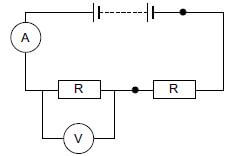
Which one of the following combinations correctly represents the changes in the reading on the voltmeter and the ammeter when a copper wire is used to connect the two black dots? (2)
| Voltmeter reading | Ammeter reading | |
| Increases | Increases | |
| Increases | Decreases | |
| Decreases | Decreases | |
| Decreases | Increases |
1.8 Two blocks, P and Q, manufactured from the SAME MATERIAL (coefficient of kinetic friction is μ in both cases) and with masses of 2m and m respectively,are placed on the hypotenuse of a triangular wooden block as shown below.The distance between the blocks is x. The heavier block (P) is above Q. When they are released SIMULTANEOUSLY, they move down the inclined plane at increasing velocity.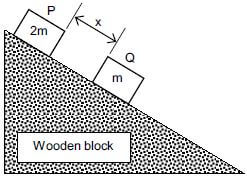
How is the distance x affected while the two blocks move?
- Increases.
- Decreases.
- Remains the same.
- It is not possible to tell from the available information. (2)
1.9 A ball is dropped from rest. Ignore air friction. Which one of the following graphs best represents the relationship between:
each of kinetic energy (K),gravitational potential energy (U) and mechanical energy (M) as functions of the displacement of the ball? (2)
1.10 Three electric charges, each with magnitude Q, are kept stationary in thesame plane at three corners (X, Y and Z) of a rectangle. The long and short sides of the rectangle have lengths of 2r and r respectively.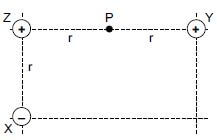
The NET ELECTROSTATIC force on the charge at Z, due to the other TWO charges, is equal to F.
The charge at Y is then MOVED and placed at P, and the charge at X is REPLACED by another negative charge with a different magnitude. What should the magnitude of the NEW charge at X be to keep the MAGNITUDE ofthe NET ELECTROSTATIC force on the charge at Z the same as before?
- 4Q
- 2Q
- Q
- Q (2)
[20]
QUESTION 2
A block of mass 4 kg is connected to another block of mass 2 kg by a light,inextensible string. The system is pulled up a rough plane, inclined at 30° to the horizontal, by means of a constant force of 73,8 N parallel to the plane, as shown inthe diagram below.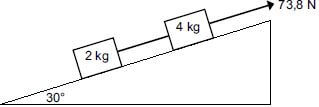
The magnitude of the kinetic frictional force on the 4 kg block is 20 N. The coefficientof kinetic friction applicable to the 2 kg block is 0,589.
2.1 Define the concept frictional force. (2)
2.2 State Newton's second law of motion in words. (3)
2.3 Draw a free-body diagram, with labels, showing ALL the forces acting on the 4 kg block as it moves up the incline. Please be mindful of the following:
- You may not include components of forces in your diagram.
- You may not use numbers as labels. (5)
2.4 Calculate the magnitude of the kinetic frictional force on the 2 kg block. (4)
2.5 Calculate the tension in the string that connects the two blocks. (6)
2.6 The system is pulled up the rough incline once more, but this time the twoblocks are swapped as indicated below. How will this influence each of thefollowing? Choose your answer from DECREASES, REMAINS THE SAMEor INCREASES.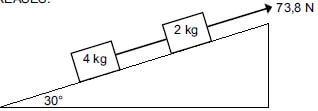
2.6.1 The acceleration of the 2 kg block (2)
2.6.2 The force of friction on the 4 kg block (2)
2.6.3 The tension in the string (2)
[26]
QUESTION 3
A stationary rocket on the ground is launched vertically upwards. After 4 s, the rocket's fuel is used up when it is 225,6 m above the ground (Point R). At this instant the velocity of the rocket is 112,8 m·s-1. The rocket reaches its MAXIMUM heightABOVE ground at point S. Ignore the effects of air friction. Assume that g does not change during the entire motion of the rocket.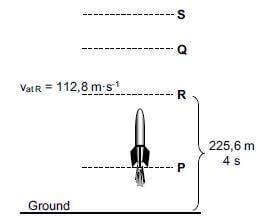
3.1 Draw a free-body diagram, with labels, of the forces acting on the rocket at point P. The lengths of your arrows should represent the comparative magnitudes of the forces. (3)
3.2 What is the direction of the acceleration of the rocket at:
3.2.1 point P; and (1)
3.2.2 point Q? (1)
3.3 At which point (P or Q) is the rocket in free fall? Give a reason for theanswer. (2)
3.4 Take UPWARD MOTION as POSITIVE and use ONLY EQUATIONS OF MOTION to calculate the following:
3.4.1 The magnitude of the acceleration of the rocket between theground and point R (3)
3.4.2 The time it takes from the moment the rocket is launched until itstrikes the ground again (6)
3.5 Take UPWARD AS POSITIVE and sketch a velocity-time graph for the motionof the rocket from the moment it is launched (at t = 0 s) until it strikes theground.
Indicate the following values on the graph:
- Velocity of the rocket on the ground
- Velocity of the rocket at each of points R and S
- Time at point R; and
- Time at which the rocket strikes the ground. (6)
[22]
QUESTION 4
Percy, mass 75 kg, rides at 20 m.s-1 on a quad bike (motorcycle with four wheels) with a mass of 100 kg. He suddenly applies the brakes when he approaches a red traffic light on a wet and slippery road. The wheels of the quad bike lock and the bike slides forward in a straight line. The force of friction causes the bike to stop in 8 s.
4.1 Define the concept momentum in words. (2)
4.2 Calculate the change in momentum of Percy and the bike, from themoment the brakes lock until the bike comes to a stop. (4)
4.3 Calculate the average frictional force exerted by the road on the wheels tostop the bike. (4)
4.4 Write down the work-energy theorem in words. (2)
4.5 Calculate the work done by the frictional force to stop the bike. (3)
[15]
QUESTION 5
A block of wood, mass 1,595 kg, is placed on the edge of a table 1,5 m above thefloor.The block is struck by a bullet, mass 0,005 kg, moving at an UNKNOWN horizontal velocity. After the impact, the bullet is embedded in the block, which falls tothe floor. The block strikes the floor with a speed of 5,6 m.s-1. Ignore all types of friction.
5.1 State the principle of conservation of mechanical energy in words. (2)
5.2 Use the principle of conservation of mechanical energy to calculate themagnitude of the velocity with which the block leaves the table. (5)
5.3 State the principle of conservation of momentum in words. (2)
5.4 Calculate the magnitude of the velocity with which the bullet strikes theblock. (4)
[13]
QUESTION 6
The speed of sound in air depends among others on the air temperature. The following graph shows this relationship.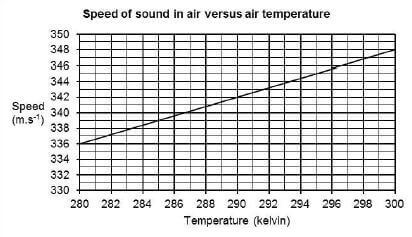
6.1 Which one of temperature or speed is the dependent variable? (1)
6.2 The gradient of this graph is equal to 0,6 m·s-1·K-1. With how much does the speed, in m·s-1, increase for every 5 K increase in temperature? (1)
6.3 Two experiments are done to verify the Doppler Effect. In the first experiment, an object approaches a stationary observer X at a constant speedof 57,5 m·s-1. The object is equipped with a siren that emits sound waves at afixed frequency of 1 000 Hz. The motion takes place in still air at a temperature of 295 K.
6.3.1 Describe what the Doppler Effect is. (2)
6.3.2 What is the speed of sound, in m·s-1, in air at 295 K?HINT: Use the graph (1)
6.3.3 Calculate the frequency measured by observer X. (4)
6.3.4 In the second experiment, the object moves away from observer X at the same constant speed as before. What should the air temperature, in kelvin, be to make it a fair test between the two experiments? (1)
6.4 Consider the three diagrams below. Each one represents the source (with the siren) and observer X. Two of the diagrams are applicable on the above mentioned experiments.
6.4.1 Which diagram is applicable to experiment 2? (1)
6.4.2 Which diagram is NOT applicable to any of the experiments?Give a reason for your answer. (2)
[13]
QUESTION 7
7.1 A small metal sphere X, on an insulated stand, carries a charge +2 nC.nC.
7.1.1 What is an electric field? (2)
7.1.2 Draw the electric field pattern associated with X. (2)
7.1.3 Calculate the magnitude of the electric field at any point 1 m from the centre of X. (3)
7.2 An identical sphere Y, which carries a charge of -7nC, is used to touch X.The two spheres are afterwards placed 2 m apart as shown below.
7.2.1 In which direction did the electrons flow while X and Y were incontact? Write down X TO Y or Y TO X. (1)
7.2.2 Calculate the charge on X after the separation. (3)
7.2.3 State Coulomb's law in words. (3)
7.2.4 Calculate the electrostatic force that is exerted on X due to the presence of Y. (5)
[19]
QUESTION 8
A satellite orbiting at a height h above the earth's surface. the height h is 5% of the earth's radius.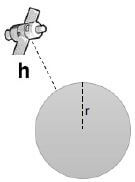
8.1 State Newton's Law of Universal Gravitation in words (2)
8.2 Calculate the value of g at the height above the earth's surface (5)
8.3 How would the value of g in QUESTION 8.2 above change if the value of h is decreased? Write down INCREASE, DECREASE or REMAIN THE SAME (1)
8.4 With what factor would the gravitational force of attraction between the satellite and the earth change if the distance between theri centres is halved? Justify your answer. (3)
[11]
QUESTION 9
A design engineer in charge of the crash worthiness of new automobiles models conducts experiments by smashing them into fixed massive barriers at 50 km.h-1.A new model of a car of mass 1 500 kg takes 0,15 s from the time of impact until it is brought to rest.
9.1 Define the term impulse. (2)
9.2 Calculate the impulse of the car. (5)
9.3 Calculate the average force exerted by the barrier on the car. (4)
[11]
TOTAL: 150
PHYSICAL SCIENCES PHYSICS PAPER 1 GRADE 12 QUESTIONS - NSC PAST PAPERS AND MEMOS JUNE 2016
Physical Sciences P1
Grade 12
June 2016
NSC Past Papers And Memos
INSTRUCTIONS AND INFORMATION
- This question paper consists of TEN questions.
- Answer ALL the questions
- Number the answers correctly according to the numbering system used in this question paper
- Leave ONE line between two sub questions, for example betweenQUESTION 2.1 and QUESTION 2.2.
- Write neatly and legibly
- You may use a non-programmable calculator
- You may use appropriate mathematical instruments
- Show ALL formulae and substitutions in ALL calculations
- Round off your FINAL numerical answers to a minimum of TWO decimal places
- Give brief motivations, discussions, et cetera where required
QUESTIONS
QUESTION 1: MULTIPLE-CHOICE QUESTIONS
Four options are provided as possible answers to the following questions. Each question has only ONE correct answer. Write only the letter (A–D), corresponding to the correct answer of your choice, next to the question number (1.1–1.10) in theANSWER BOOK, for example 1.11 D.
1.1 The diagram below shows a compressed spring between two trolleys initially at rest on a horizontal, frictionless surface. Trolley A has a mass of 2 kg and trolley B has a mass of 1 kg. A string holds the trollies together.
The string is cut and the trollies move apart. Compared to the magnitude ofthe force the spring exerts on trolley A, the magnitude of the force the spring exerts on trolley B is …
- half as great.
- the same
- twice as great.
- four times as great. (2)
1.2 A net force acts on each of the isolated objects, R and S, as shown below.
The mass of S is three times that of R. When effects of friction are ignored,the rate of change of momentum of S is X. What is the rate of change of momentum of R under the same conditions?
- 1/9X
- 1/3X
- X
- 3 X (2)
1.3 An object moving with a constant velocity v has a kinetic energy E. Which one of the following will be true for the kinetic energy if the object has aconstant velocity of 2v?
- ½ E
- E
- 2E
- 4E (2)
1.4 A sphere is attached to a string, which is suspended from a fixed horizontal bar as shown in the sketch.
The reaction force to the gravitational force exerted by the earth on thesphere is the force of the …
- bar on the sphere.
- string on the sphere.
- sphere on the earth.
- bar on the string. (2)
1.5 A ball is dropped from height h above the ground and reaches the ground with kinetic energy E. From which height must the ball be dropped to reach the ground with kinetic energy 2E? (Ignore all effects of friction.)
- 2h
- 3h
- 4h
- 8h (2)
1.6 The velocity versus time graph below represents the movement of an object under the influence of gravitational force ONLY.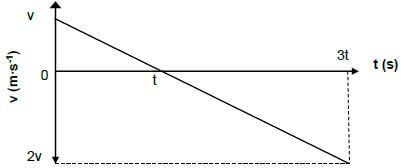
The displacement of the object in time 3t is …
- ?/?vt.
- 7vt
- ?/?vt.
- -?/?vt. (2)
1.7 A net force F accelerates two isolated objects, P and Q, from rest on a straight line for time t as shown below. Object P experiences an acceleration of a and object Q an acceleration of 2a.
If the amount of work done by net force F on object P equals W, the amount of work done on Q will be …
- W.
- ½ W.
- 2 W.
- 4 W. (2)
1.8 Which ONE of the following can be explained by the Doppler Effect?
- A source of sound moves closer to a listener, the sound observed by the listener becomes louder.
- If light shining on a metal has a frequency that is high enough,electrons will be emitted from the metal.
- A spectrum will be shifted towards shorter wavelengths than expected if the light comes from distant celestial objects moving towards the observer.
- A spectrum of frequencies of electromagnetic radiation is emitted when an atom makes a transition from high energy to a lower energy state. (2)
1.9 The red shift can be used to estimate the speed of a galaxy relative toearth. Which ONE of the following statements is CORRECT? Distant galaxies are moving …
- faster than closer galaxies and the universe is expanding.
- faster than closer galaxies and the universe is contracting.
- slower than closer galaxies and the universe is contracting.
- moving at the same speed as closer galaxies and the universe remains unchanged. (2)
1.10 A ball is dropped onto a concrete floor and bounces off the floor to thesame height from which it was dropped. Which ONE of the following laws best explains why the ball experiences an upward force? Newton’s …
- first law of motion.
- second law of motion.
- third law of motion.
- law of universal gravitation. (2)
[20]
QUESTION 2
A girl stands on a platform in a classroom. She throws a ball vertically downwardsto the floor hoping that the ball, after it bounced on the floor, will hit the ceiling of the classroom. She throws the ball with a velocity of 8 m·s-1 from the height of 1,8 m above the floor. Ignore the effects of friction. 
2.1 Write down the magnitude and direction of the acceleration of the ball immediately after the ball left her hand. (2)
2.2 Is the motion of the ball while moving downwards towards the floor a freefall? Answer YES or NO. Explain your answer. (2)
2.3 Calculate the magnitude of the velocity with which the ball hits the floor. (4)
2.4 How long does it take the ball to hit the floor? (3)
| The ball bounces INELASTICALLY on the floor where the velocity of the ball DECREASES by 20%. The ball is in contact with the floor for 0,01 s. |
2.5 Determine by means of calculations, whether the ball will reach the ceiling after its first bounce on the floor. (5)
2.6 Sketch a velocity-time graph for the motion of the ball, from the time the ball is thrown until it reaches the maximum height after the bounce.
Clearly show the following on the graph:
- The initial velocity of the ball
- The velocity and time when the ball hits the floor
- The velocity and time when the ball leaves the floor (4)
[20]
QUESTION 3
A crate of mass 86 kg is accelerating down a surface inclined at an angle of 25° to the horizontal.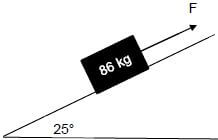
A man applies a force F upwards parallel to the plane in an attempt to prevent the crate from sliding down the inclined plane. In spite of the man’s efforts the crate is accelerating down the incline.
3.1 The applied force is a non-conservative force. What is meant by a non-conservative force? (2)
3.2 The coefficient of kinetic friction (μ?) between the crate and the surface ofthe plane is 0,22. Prove that the magnitude of the kinetic frictional force is168,04 N. (2)
3.3 State work-energy theorem in words. (2)
3.4 Draw a labelled free-body diagram of all the forces acting on the crate. (4)
3.5 The crate accelerates parallel down the inclined plane for a distance of0,9 m at 1,54 m·s-2. Use the work-energy theorem and calculate the workdone by the man on the crate. (5)
[15]
QUESTION 4
A 5 kg rigid crate moves from rest down path ABC as shown in the diagram below
(diagram not drawn to scale).
Section AB of the path is frictionless whilst section BC is a rough surface. Assume that the crate moves in a straight line down the path.
4.1 State, in words, the principle of the conservation of mechanical energy. (2)
4.2 Use the principle of the conservation of mechanical energy to calculate the velocity of the crate when it reaches point B. (4)
| On reaching point B, the crate continues to move down the section BC ofthe path. It experiences an average frictional force of 10 N and reaches point C at a velocity of 4 m·s-1. |
4.3 Apart from friction, write down the names of TWO other forces that act onthe crate as it moves down section BC. (2)
4.4 In which direction does the net force act on the crate as it moves downsection BC? Write down only B to C or C to B. (1)
| Another crate of mass 10 kg now moves from point A down path ABC. |
4.5 How will the velocity of this 10 kg crate at point B compare to that of the5 kg crate at B?
Write down only GREATER, SMALLER or EQUAL TO. (1)
[10]
QUESTION 5
5.1 A submarine can use the Doppler effect to detect the speed of the ship. A submarine at rest and just below the surface of the water, detects the frequency of a moving ship as 437 Hz, which is 0,985 times the actual frequency of the sound emitted by the ship. The speed of sound in water is1 470 m·s-1.
5.1.1 State Doppler effect in words. (2)
5.1.2 Is the ship moving away from or towards the submarine? Give areason for your answer. (2)
5.1.3 Calculate the speed of the ship. (5)
5.2 Light emitted from distant stars demonstrates the phenomenon known as red shift.
Explain how the phenomenon known as red shift can be used to explain an expanding universe. (2)
5.3 Absorption spectra from the Sun and another galaxy is shown below:
Study the atomic absorption spectra and answer the question that follows: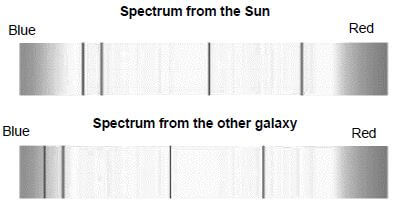
Does the spectrum of the other galaxy constitute a RED SHIFT or BLUESHIFT? (1)
[12]
QUESTION 6
A 4 kg block on a horizontal, rough surface is connected to an 8 kg block by a light, inelastic string that passes over a frictionless pulley as shown below. Thecoefficient of kinetic friction between the block of 4 kg and the surface is 0,6.
6.1 Draw a free-body diagram showing the forces acting horizontally on the4 kg block. (2)
6.2 Calculate the acceleration of the system. (7)
6.3 Calculate the magnitude of the tension in the string. (3)
6.4 Calculate the magnitude of the frictional force that acts on the 4 kg block. (4)
[16]
QUESTION 7
Collisions between vehicles take place on the roads in our country daily. In one ofthese collisions, a car of mass 1 650 kg, travelling at a velocity of 25 m·s-1 to the left, collides head-on with a minibus of mass 3 050 kg, travelling at 15 m·s-1 to the right. The two vehicles move together as unit in a straight line after collision.
7.1 Calculate the velocity of the two vehicles after the collision. (5)
7.2 Prove by means of calculations that the collision was inelastic. (9)
7.3 New cars have crumple zones to help minimise injuries during accidents.
Airbags and padded interiors can also help to reduce the chances of fatalinjury or serious injury.
Use a principle in Physics to explain howcrumple zones can reduce the chances of fatal or serious injury. (3)
[17]
QUESTION 8
The diagram below shows a spaceship, with a mass of 3 500 kg, travelling in the vacuum of space in an orbit around the earth, with a mass of
5,98 × 1024 kg at a constant speed. There is a distance of 8,53 × 106 m between the earth and the spaceship centres.
8.1 Define the Newton’s law of Universal Gravitation. (2)
8.2 Calculate the gravitational force that the earth exerts on the spaceship. (4)
8.3 How does the force exerted by the spaceship on the earth compare to theforce calculated in QUESTION 8.2 above?
Write ONLY greater than, smaller than or equal to. (1)
8.4 Name and state the Newton’s Law of motion used to make a choice in QUESTION 8.3 above. (3)
8.5 Due to the change in the distance between the earth and the spaceship centres, the force increased by a factor of 4. Calculate the new distance between the earth and the spaceship centres. (4)
[14]
QUESTION 9
Two identical objects P and Q with a mass of 10 kg each, are moving side by side with an initial velocity of 5,5 m·s-1 east on a horizontal surface. The following graphs show the net force experienced by each object respectively during thesame time interval.
9.1 Calculate the total impulse experienced by object Q in 10 s. (5)
9.2 Compare without using any calculations the total impulse for object P withthat of object Q.
Write down only GREATER THAN, LESS THAN or EQUAL TO. (2)
9.3 Calculate the final velocity of object Q. (4)
[11]
QUESTION 10
Two point charges of magnitudes +4 nC and -6 nC are placed at points A and C respectively. These charges are respectively 20 mm and 25 mm away from point R as shown in the diagram below:
10.1 Draw the electric field pattern formed between the two point charges(A and C). (3)
10.2 Calculate the net electric field at R due to the two point charges. (7)
10.3 If the distance between the two charges (A and C) is reduced by 15 mm.
Calculate the electrostatic force that charge A exerts on charge C. (5)
[15]
TOTAL: 150
DATA FOR PHYSICAL SCIENCES GRADE 12 PAPER 1 (PHYSICS)
TABLE 1: PHYSICAL CONSTANTS
| NAME | SYMBOL | VALUE |
| Acceleration due to gravity | g | 9,8 m·s-2 |
| Universal gravitational constant | G | 6,67 × 10-11 N·m2·kg-2 |
| Speed of light in a vacuum | c | 3,0 × 108 m·s-1 |
| Planck's constant | h | 6,63 × 10-34 J·s |
| Coulomb's constant | k | 9,0 × 109 N·m2·C-2 |
| Charge on electron | e | -1,6 × 10-19 C |
| Electron mass | me | 9,11 × 10-31 kg |
| Mass of Earth | M | 5,98 × 1024 kg |
| Radius of Earth | RE | 6,38 × 103 km |
TABLE 2: FORMULAE
MOTION
FORCE
WORK, ENERGY AND POWER
| W = F∆ x cos ⊖ | U = mgh or Ep = mgh |
| K = ½ MV2 or Ek = ½ mv2 | Wnet = ∆K or Wnet Ek W ∆K = Kf - Ki or ∆Ek = EKf - Eki |
| Wnc = ∆K + ∆U or Wnc = ∆Ek + ∆Ep | Pav = FVav , Pgemid = Fvgemid |
| P = W/∆t |
WAVES, SOUND AND LIGHT
| fL = V ± VL FS or FL = V ± VLFb V ± VS V±Vb | E = hf E = h c/λ |
ELECTROSTATICS
| F = KQ1Q2 r2 | E = kQ r2 |
| E = F/q | V = W/q |
| n = Q / e or n = Q/qe |
PHYSICAL SCIENCES PHYSICS PAPER 1 GRADE 12 MEMORANDUM - NSC PAST PAPERS AND MEMOS JUNE 2016
Physical Sciences
P1
Grade 12
June 2016 Memorandum
Nsc Past Papers And Memos
MEMORANDUM
QUESTION 1
| 1.1 B 1.2 C 1.3 D 1.4 C 1.5A 1.6 D 1.7 C 1.8 C 1.9 A 1.10 C |
[20]
QUESTION 2
| 2.1 | 9,8 m·s-2 ✓ , downwards✓ | (2) | ||||
| 2.2 | Yes✓ Only gravitational force is acting on the ball ✓ OR The ball is moving under the influence of its weight✓ |
(2) | ||||
| 2.3 |
|
(4) | ||||
| 2.4 | POSITIVE MARKING FROM 2.3
|
(3) |
| 2.5 | POSITIVE MARKING FROM 2.3
|
(5) |
| 2.6 | 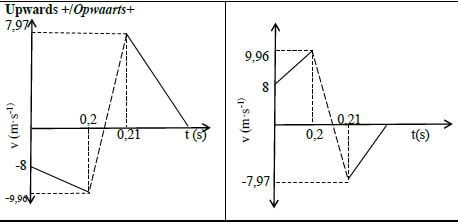 | |||||||||||||||||||||
Upwards as positive
Upwards as positive
|
(4) |
[20]
QUESTION 3
| 3.1 | A force for which the net work done in any closed path is dependent on the path the object travelled ✓✓ | (2) | ||||||||
| 3.2 | Fk =μkN = 0,22 × 86 × 9,8 Cos 25º✓ = 168,04 N ✓ | (2) | ||||||||
| 3.3 | The net work done on the object is equal ✓ to the change in the object’s kinetic energy OR The work done on an object by a resultant/net force is equal ✓ to the change in the object’s kinetic energy |
(2) | ||||||||
| 3.4 | Accepted labels
|
(4) | ||||||||
| 3.5 |
|
(5) |
[15]
QUESTION 4
| 4.1 | The total Mechanical Energy is conserved/ remains constant ✓ in an isolated system / in absence of external forces/ non-conservative forces ✓ OR The sum of gravitational potential energy and kinetic energy of an object remains constant ✓ in an isolated system✓ |
(2) | ||
| 4.2 |
| (4) | ||
| 4.3 | Weight / force of gravity✓ Normal force✓ | (2) | ||
| 4.4 | C to✓ | (1) | ||
| 4.5 | Equal to✓ | (1) |
QUESTION 5
| 5.1.1 | The apparent change in the detected frequency (pitch ) or (wavelength) ✓ as a result of the relative motion between a source and an observer (listener) ✓ | (2) | ||
| 5.1.2 | Away (from submarine)✓ The detected /observed frequency is lower than the actual frequency✓ | (2) | ||
| 5.1.3 |
| (5) | ||
| 5.2 | Red shift implies that light emitted by stars shows a shift towards the lower frequencies of the spectrum✓✓ | (2) | ||
| 5.3 | Blue shift✓ | (1) |
[12]
QUESTION 6
| 6.1 | | (2) | ||||
| 6.2 |
| (7) | ||||
| 6.3 |
| (3) | ||||
| 6.4 |
| (4) |
[16]
QUESTION 7
| 7.1 | Choose RIGHT as positive |
(5) |
| 7.2 | Σ?? = ½ mMB v2iMB + ½ mC v2iC ✓ = ½(3 050)(15)2 + ½(1 650)(-25)2✓ = 85 8750 J✓ Σ?? = ½mMB v2fMB + ½ mC v2fC ✓ = ½(3 050)(0,96)2✓+ ½(1 650)(0,96)2✓ = 2 165,76 J ✓ Since Σ?? ≠ Σ?? ✓ ∴ the collision was inelastic✓ |
(9) |
| 7.3 | Crumple zones in a car ensure that the car comes to rest over a longer period of time✓, (Δt), during an accident / stopping time is increased. From FNET ∝ 1/Δt , it follows that FNET decreases with an increase in Δt. ∴ The magnitude of FNET determines the extent of passenger’s injuries. ✓ |
(3) |
[17]
QUESTION 8
| 8.1 | Every object in the universe attracts every other object with a force ✓that is directly proportional to the product of the masses and inversely proportional to the square of the distance between their centers. ✓ | (2) |
| 8.2 | Data: ME (Mass of the earth) = 5,98 × 1024 kg MS (mass of the spaceship) = 3 500 kg r = 8,53 × 106 m G = 6,67 × 10-11 N·m2·kg-2 F = ? ?? ∙??✓ = (6,67 × 10−11)(5,98 × 1024 )(3500)✓ = 19 186,55 N✓ ?2 (8,53 × 106 )2✓ |
(4) |
| 8.3 | Equal to✓ | (1) |
| 8.4 | Newton’s third law of motion✓ When object A exerts a force on object B, object B simultaneously exerts an equal force✓ on object A in an opposite direction✓. | (3) |
| 8.5 | F = ? ?? ∙??✓ ?2 4 × 19 186,55 ✓ = (6,67 × 10−11)(5,98 × 1024 )(3500)✓ ?2 ?2 = (6,67 × 10−11)(5,98 × 1024 )(3 500) 76 746,2 ?2 = 1,82 × 1013 m2 ? = 4 265 000,54 m✓ = 4,27 × 106 m |
(4) |
[14]
QUESTION 9
| 9.1 | Impulse = Area under graph ✓ Any ONE = ½ bh + ½ bh + lb = ½( 2)(10) ✓ + ½ (2)(-10) ✓ + 6(-10) ✓ = - 60 N.s in opposite direction✓ |
(5) |
| 9.2 | Greater than✓✓ | (2) |
| 9.3 | East positive Impulse = mvf – mvi ✓ -60 = 10vf – (10)(5,5) ✓ Vf = 0,5 m·s-1✓ |
(4) |
[11]
QUESTION 10
| 10.1 |
CRITERIA TO MARK THE PATTERN |
(3) |
| 10.2 | EA = ? ??✓ EC = ? ?? = (9 × 109)(6 × 10−9) ✓ = 86 400 N·C-1, to the right |
(7) |
| 10.3 | F= ? ????✓ ?2 = (9 × 109)(4 ×10−9)✓(6 ×10−9)✓ (30×10−3)2✓ = 7,2 ×10-3 N, (attraction)✓ |
(5) |
[15]
Total : 150
